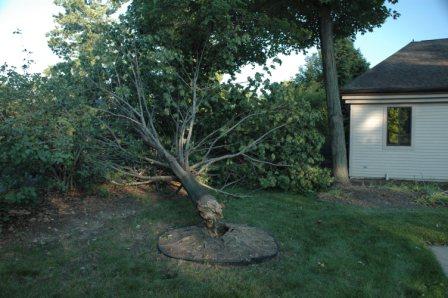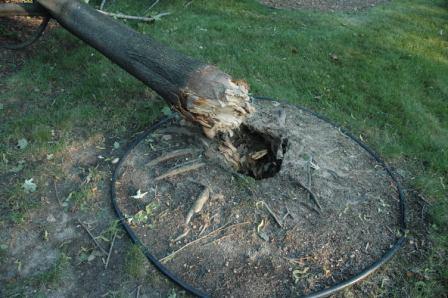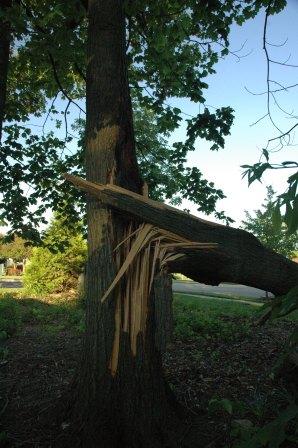This past weekend marked our first real bout with severe thunderstorms here in Mid-Michigan. Several lines of storms moved through the mid and southern part of the state and northern Ohio. The storms in southern Michigan and Ohio also spawned some tornadoes. Around here, storm damage was confined mainly to downed trees causing power outrages and some damage to homes and buildings.
Severe weather outbreaks provide some opportunities to observe tree failures and gain insights into how they can be prevented. Or, as Yogi Berra put it, “You can observe a lot just by watching”. I was at a little disadvantage in scouting out tree damage from out most recent storm because we were traveling over the weekend and I wasn’t able to get out and about to survey damage until Monday evening. As it turns out the area most heavily affected by the storm is also fairly affluent. Folks in these neighborhoods don’t tolerate downed trees lying around very long. Nevertheless, I did make a couple of interesting finds.

A common sight after a storm in this area is wind-throw in shallow-rooted species, such as spruce and pines. We didn’t see a lot after the current storm, which was probably due to the fact that the storm moved through quickly – most of the high winds lasted only a few minutes – and the storm was not preceded by prolonged heavy rains.

I don’t have any specific data but I have seen several cases where wind-throw was occurred on trees in which mulch was underlain with landscape fabric. Perhaps coincidence, but another strike against the stuff in my mind.

This maple provided one of the best (or worst) examples I have seen of planting too deep. The tree snapped off about 6” below ground line.

Note that there are plenty of pretty stout roots that look like structural roots near the surface, but none of these originated near the current ground line. The tree was on private property and time constraints prevented me from getting permission to do an excavation, nevertheless, it would be interesting to try to find the original root flare.

By far the most common problem in this storm, and most of our typical thunderstorms, was large limb breakage associated with narrow crotches. This occurred in a variety of species; oaks, maples, elms, pines. Narrow branch angles often form from multiple leaders, which results in weak branch attachment as included bark forms and gradually reduce the proportion of wood attaching the branch to the tree. The encouraging thing, or maybe discouraging depending on your point of view, is that this is one of the most easily preventable tree defects. Pruning double leaders or multiple leaders back to single leaders and eliminating other poor branch angles when small can easily prevent this type of breakage. For most of our garden-variety thunderstorms, eliminating narrow crotches would probably eliminate 50% or more of our tree-related storm damage.
Bert, I wish the “build a better tree” people would read this last paragraph. ISA arborists have been railing about the practice of heading back saplings to create columnar, acutely-angled trees so beloved by city planners. I blogged about this several months ago, but don’t know how prevalent the practice is outside the Pacific NW. (Also, in that landscape fabric example –
looks like there’s a circling root mass, doesn’t it?)
We had big winds here in MA Sunday, and yesterday I got phone calls from three different clients who had had blowdowns. One tree was a youngish Norway maple volunteer, one was two stems of a huge 4-trunked Norway maple, and one was a 14″ caliper double-leadered hemlock. All the rooting conditions were fine. The hemlock split at its narrow crotch, about 15′ up. The little Norway maple is one of a group I’ve been trying to convince my client to replace with more appropriate trees; maybe the blowdown will help me with that argument. The big Norway was the most important blowdown; it was located on an ocean bluff in a place where its roots didn’t interfere with other roots, and the sunlight that now pours in will be a revelation (and maybe a shock) to the shade-loving garden behind it. Its replacement will also create shade, but with less volume (for now) and density.
Yesterday I heard Dennis Ryan of UMass on the radio talking about the damage caused in MA by Sunday’s storms. He mentioned that municipal trees saw quite a few losses because in the last 20 or so years towns and cities have cut budgets for vegetation management. Utility companies have found that keeping vegetation on a 4-5 year pruning schedule helps to lessen the amount of damage caused by any one storm (though the erratic winds that came Sunday would test any tree, really, as they didn’t come from the direction of prevailing wind).
I’ve got a black walnut tree with a narrow crotch I worry about. It’s at least fifty years too late to correct it. When it does come off it won’t fall towards the house at least.
After reading this post I did a little excavating around the base of a small Japanese maple (5 ft and 4 yrs since installation) in a new client’s garden today. I basically found the same root and planting depth situation as the maple in your photo, just in miniature. What to do? It’s unlikely that any extreme weather will impact it so definitely. The same is true of a small multi-trunked Magnolia (probably an M. stellata cross), with the further insult of one trunk likely to die in the next year or two because the elastic cord the ID tag was attached to wasn’t removed and has now been engulfed by the bark. I think it’s a bit late in the season to do anything significant about either of these trees but should I dig them up early next season and correct the roots and the planting depth? is it too late in general? or, because they both look healthy and are growing well, should I keep to the adage, “If it ain’t broke, don’t fix it?”
Natasha, at ISA field days I’ve recommended digging up and replanting if trees/shrubs are planted too deeply and/or you can see circling/girdling roots. You can do this in the fall after the trees have gone dormant, unless you’re in a really cold area with sufficient summer moisture, in which case I know Bert would recommend doing this in the spring instead!